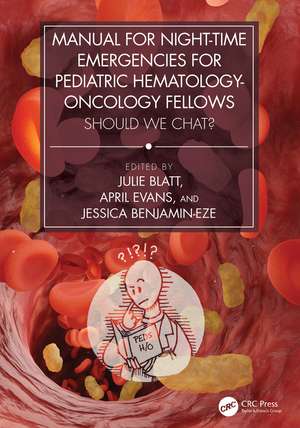Manual for Night-Time Emergencies for Pediatric Hematology-Oncology Fellows: Should We Chat?
Editat de Julie Blatt, April Evans, Jessica Benjamin-Ezeen Limba Engleză Paperback – 18 sep 2024
This manual is intended as a one-stop solution for such frantic moments - a quick resource to bridge the hours between the start of night call and morning rounds that focuses on what needs to be done immediately to avoid hurting a patient. It offers succinct guidelines and algorithms to address the emergencies most likely to come up overnight. For those tempted to turn to AI for quick solutions, there are some salutary lessons from responses AI has given when asked about such emergencies.
| Toate formatele și edițiile | Preț | Express |
|---|---|---|
| Paperback (1) | 337.26 lei 3-5 săpt. | +15.96 lei 7-13 zile |
| CRC Press – 18 sep 2024 | 337.26 lei 3-5 săpt. | +15.96 lei 7-13 zile |
| Hardback (1) | 843.60 lei 6-8 săpt. | |
| CRC Press – 18 sep 2024 | 843.60 lei 6-8 săpt. |
Preț: 337.26 lei
Preț vechi: 355.02 lei
-5% Nou
Puncte Express: 506
Preț estimativ în valută:
64.54€ • 66.87$ • 53.87£
64.54€ • 66.87$ • 53.87£
Carte disponibilă
Livrare economică 01-15 martie
Livrare express 15-21 februarie pentru 25.95 lei
Preluare comenzi: 021 569.72.76
Specificații
ISBN-13: 9781032749631
ISBN-10: 1032749636
Pagini: 162
Ilustrații: 66
Dimensiuni: 178 x 254 x 11 mm
Greutate: 0.3 kg
Ediția:1
Editura: CRC Press
Colecția CRC Press
Locul publicării:Boca Raton, United States
ISBN-10: 1032749636
Pagini: 162
Ilustrații: 66
Dimensiuni: 178 x 254 x 11 mm
Greutate: 0.3 kg
Ediția:1
Editura: CRC Press
Colecția CRC Press
Locul publicării:Boca Raton, United States
Public țintă
Professional Practice & DevelopmentCuprins
Preface. List of contributors. Acknowledgments. List of abbreviations
I. Oncology
1. High White Blood Cell (WBC) Count. 2. Mediastinal Mass/ Superior Vena Cava (SVC) Syndrome. 3. Spinal/Paraspinal Mass. 4. Massive Hepatomegaly. 5. Tumor Lysis Syndrome (TLS)/Metabolic Abnormalities. 6. Differentiation Syndrome or Retinoic Acid Syndrome. 7. Fever in High-Risk Populations. 8. Typhlitis. 9. Methotrexate Toxicity. 10. Posterior Reversible Encephalopathy Syndrome (PRES).
II. Hematology
11. Severe Anemia. 12. Hemolytic Anemia. 13. Thrombotic Microangiopathy (TMA). 14. Transfusion Emergencies. 15. Sickle Cell Emergencies. 16. ACS in SCD. 17. Aplastic crisis in SCD. 18. Hemolytic crisis in SCD. 19. Pain/Vascoocclusive crisis. 20. Priapism in SCD. 21. Splenic sequestration. 22. Stroke/TIA in SCD. 23. Deep Venous Thrombosis (DVT)/Central Venous Thrombosis. 24. Pulmonary Embolus (PE). 25. Arterial Thrombosis. 26. Arterial (Acute Ischemic) Stroke. 27. Heparin-Induced Thrombocytopenia (HIT). 28. Bleeding Emergencies. 29. Thrombocytopenia with/without Bleeding. 30. Hemophilia. 31. Von Willebrand Disease. 32. Vitamin K Deficiency. 33. Other Factor Deficiencies. 34. Neonatal Hematologic Emergencies. 35. Covid and Hematologic Emergencies. 36. Hemophagocytic Lympho-Histiocytosis (HLH).
III. Vascular Anomalies
37. Pain . 38. Cellulitis vs inflammation. 39. Effusions with/without organ failure. 40. Pulmonary Embolus in vascular anomalies. 41. Kasabach-Merritt Phenomenon.
IV. General
42. Managing Symptoms at the End of Life. 43. What to do when a patient dies. 44. What ChatGPT says: Postscript.
Index.
I. Oncology
1. High White Blood Cell (WBC) Count. 2. Mediastinal Mass/ Superior Vena Cava (SVC) Syndrome. 3. Spinal/Paraspinal Mass. 4. Massive Hepatomegaly. 5. Tumor Lysis Syndrome (TLS)/Metabolic Abnormalities. 6. Differentiation Syndrome or Retinoic Acid Syndrome. 7. Fever in High-Risk Populations. 8. Typhlitis. 9. Methotrexate Toxicity. 10. Posterior Reversible Encephalopathy Syndrome (PRES).
II. Hematology
11. Severe Anemia. 12. Hemolytic Anemia. 13. Thrombotic Microangiopathy (TMA). 14. Transfusion Emergencies. 15. Sickle Cell Emergencies. 16. ACS in SCD. 17. Aplastic crisis in SCD. 18. Hemolytic crisis in SCD. 19. Pain/Vascoocclusive crisis. 20. Priapism in SCD. 21. Splenic sequestration. 22. Stroke/TIA in SCD. 23. Deep Venous Thrombosis (DVT)/Central Venous Thrombosis. 24. Pulmonary Embolus (PE). 25. Arterial Thrombosis. 26. Arterial (Acute Ischemic) Stroke. 27. Heparin-Induced Thrombocytopenia (HIT). 28. Bleeding Emergencies. 29. Thrombocytopenia with/without Bleeding. 30. Hemophilia. 31. Von Willebrand Disease. 32. Vitamin K Deficiency. 33. Other Factor Deficiencies. 34. Neonatal Hematologic Emergencies. 35. Covid and Hematologic Emergencies. 36. Hemophagocytic Lympho-Histiocytosis (HLH).
III. Vascular Anomalies
37. Pain . 38. Cellulitis vs inflammation. 39. Effusions with/without organ failure. 40. Pulmonary Embolus in vascular anomalies. 41. Kasabach-Merritt Phenomenon.
IV. General
42. Managing Symptoms at the End of Life. 43. What to do when a patient dies. 44. What ChatGPT says: Postscript.
Index.
Notă biografică
Julie Blatt, M.D., Pediatric Hematology/Oncology, UNC Hospitals, University of North Carolina at Chapel Hill, Winston-Salem, USA. She is a member of the American Society of Pediatric Hematology Oncology’s Vascular Anomalies Special Interest Group, where she chairs the Practice Work Group, and of the International Society for the Study of Vascular Anomalies.
April Evans, M.D, M.P.H., Department of Hematology-Oncology, Roger Maris Cancer Center, Fargo, North Dakota, USA.
Jessica Benjamin-Eze, D.O.., Pediatric Hematology/Oncology, University of North Carolina at Chapel Hill, Winston-Salem, USA.
April Evans, M.D, M.P.H., Department of Hematology-Oncology, Roger Maris Cancer Center, Fargo, North Dakota, USA.
Jessica Benjamin-Eze, D.O.., Pediatric Hematology/Oncology, University of North Carolina at Chapel Hill, Winston-Salem, USA.
Descriere
It offers succinct guidelines and algorithms to address the emergencies most likely to come up overnight. For those tempted to turn to AI for quick solutions, there are some salutary lessons from responses AI has given when asked about such emergencies.
